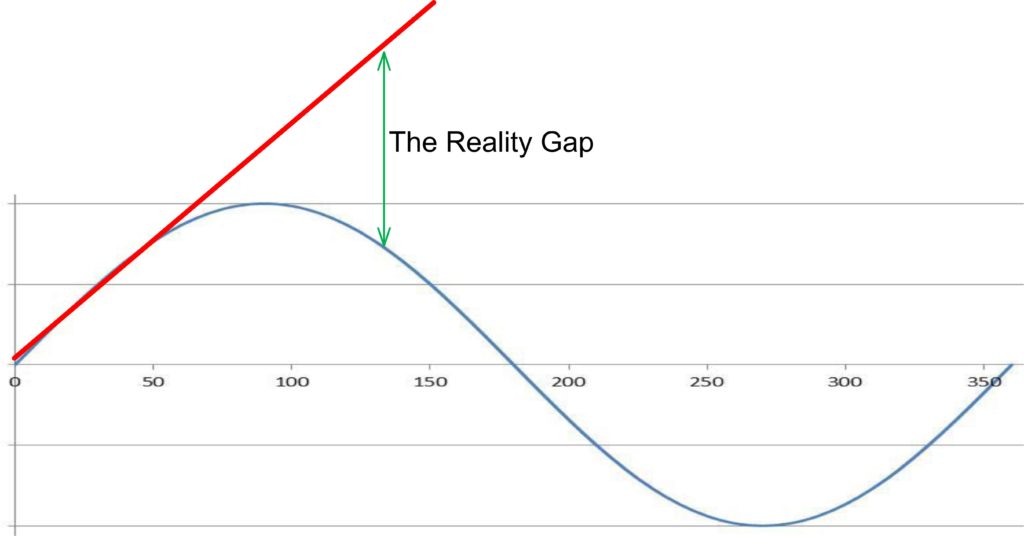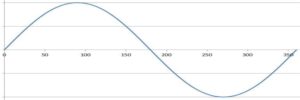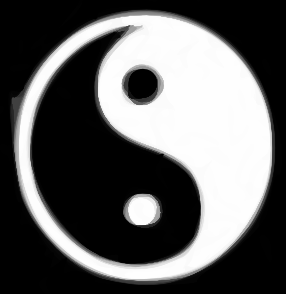Antagonistic or Complementary Opposites
This post is a sequel to one I did earlier this year, called The Shape of Our Thinking. I examined how the geometry of our thought affects how we view the world, how we think and act.
Since the argument of this post builds on that one I will very briefly summarize it here.
 Astrology conceives of reality in terms of repeating cycles of growth and change – alternating opposites like light and dark, summer and winter and so on – and of ongoing cycles through time, of birth, growth, flourishing, decline, death and decay, followed in a collective sense by a rebirth, and so on. that is represented by the sine wave.
Astrology conceives of reality in terms of repeating cycles of growth and change – alternating opposites like light and dark, summer and winter and so on – and of ongoing cycles through time, of birth, growth, flourishing, decline, death and decay, followed in a collective sense by a rebirth, and so on. that is represented by the sine wave.
The straight line is our modern view of reality as conforming to Progress, where we just keep going up and up, getting better and better, always moving forward. The straight line and the wave are pretty much in sync on the upward slope, but on the downward slope they increasingly diverge. They are profoundly different models of the world, so they shape our thoughts and actions in very different ways.
Both of these two systems have various kinds of opposite concepts that structure the model – for instance,
– light / darkness
– day / night
– summer / winter
– heat / cold
– growth / decline
– youth / age
– masculine / feminine
and so on. There are other pairs of opposites, like good and evil, that have an ethical or judgemental quality.
So how do we deal with opposites? I think it largely depends on the shape of our thinking, and in this essay I want to examine the different ways of dealing with polar opposites that go with the two shapes.
I want to start with the straight line model of reality that characterizes so much of our modern worldview.
![]() For now just consider the ends of the line.
For now just consider the ends of the line.
In a straight line model of reality the opposites are opposing, antagonistic, enemies. The ends of a straight line never meet; they just get further apart.
Now consider the following two shapes, which I think are two different forms of the same thing. This is a Sine Wave, and the Chinese Tai Chi symbol, otherwise known as Yin/Yang.

 In contrast with the straight line model, in a wave model of reality the opposites are complementary, balancing, and succeed each other through a cycle of time. Look at the Tai Chi symbol – it is basically the same model as a sine wave, which you can picture as the rotating Tai Chi symbol unfolding over time. The opposites get to an extreme and then they turn around and turn back into the other – winter reaches an extreme of cold then moves towards spring heat, Summer reaches an extreme of heat and moves towards Autumn and cold, and so on. The opposites continually transform into each other.
In contrast with the straight line model, in a wave model of reality the opposites are complementary, balancing, and succeed each other through a cycle of time. Look at the Tai Chi symbol – it is basically the same model as a sine wave, which you can picture as the rotating Tai Chi symbol unfolding over time. The opposites get to an extreme and then they turn around and turn back into the other – winter reaches an extreme of cold then moves towards spring heat, Summer reaches an extreme of heat and moves towards Autumn and cold, and so on. The opposites continually transform into each other.
The straight line model is an adversary model of reality, and as it gets older and approaches a breaking point, the opposites get more polarized and extreme. At late stages is where the opposites start to turn into each other – hate an enemy long enough and you take on the characteristics of the enemy. You become your enemy. In the late stage straight line model, it’s like the straight line bends back on itself and collapses, which merges it back into the cyclical wave model.
In the straight line dualistic model, when something goes wrong you try to figure out who is to blame – whatever is going on at the opposite, adversary pole – then find them and either exclude, exterminate or otherwise kick the s**t out of them – and the enemy is routed for now, we go back our straight line growth. We represent the forces of Good in a war against the forces of Evil.
In a cyclical model, as things go wrong, you are far more likely to view them as being out of balance, and also look for what point in a cycle they are – growing, ascending, peaking, declining – because different actions are appropriate at different phases. You’re not out looking for an adversary to blame, you’re conforming yourself to the shape, and the phase, of the world around you. The model is a different shape, so it leads to different kinds of thoughts and responses.
Now comes the fun part.
Much of our western culture is derived from, and built on, the value systems of the three main religions that had their origin in the middle east. They are called the “People of the Book” – Judaism, Christianity, and Islam – because their holy books have a shared lineage, and there are many significant parallels between the three faiths. In fact, I would argue here that their worldviews are functionally identical for what we are discussing here.
Here’s the kicker – The worldviews of the three “people of the Book” – Judaism, Christianity, Islam – are all straight line models.
In theological terminology these religions are called eschatological because they are moving towards a final end of the world or eschaton. All three of them are also highly dualistic, with opposite forces of Light and Darkness, God and the Devil locked in combat. There was a beginning of time and there will be an end, when the final battle between Light and Darkness takes place. Time is linear. As we said earlier, a straight line model of the world correlates with a dualism of antagonistic opposites. The history of these three faiths tends to confirm that statement.
interestingly, the modern worldview of positive thinking (which I discussed in a previous post on the dangers of positive thinking) is very much a child of this religious tradition, and it has a very nasty, hidden dualistic side – all of that negative stuff that they try to deny right out of existence. The earliest creators of the New Thought movement, people like Mary Baker Eddy, were very strict dualistic Presbyterians, and they carried the implied dualism into their teaching. (Read up on the history of Christian Science some time..)
We’ve been living as a western culture in a linear, dualistic model of reality for something like three thousand years now. Here in America we are definitely in the brittle later stages of our country’s lifespan – in terms of our original diagram, we are in a phase where the straight line and the sine curve are becoming increasingly out of sync – so by definition you should see increased polarization going on, increased tension, increased violence and so on.
Look at the straight line, and look at the wave, and then look around you. It’s right there in the geometry.
We are exhibiting all the symptoms of a straight line model of the world in its late stages, where we become increasingly polarized, violent and brittle, and the system shows signs of breaking down.
If I’m on to something here, then we all desperately need to recover a sense of the wisdom of the old, cyclical, polar balance kinds of world models – like Taoism, or the world model of the I Ching – and, of course, the world model of astrology – and by that I mean the model in the symbols themselves, rather than astrology having a religious system like Theosophy, or an eastern model like karma and reincarnation, superimposed from outside. We need to let the symbols speak for themselves.
There are other models in the world today that are coming from a place of inclusive, balanced wholeness rather than an antagonistic dualism, and they are moving towards a new model of wholeness.The Jungian model of individuation, where opposites are accepted and somehow made part of a larger whole, is another modern map of an inclusive and cyclical model. The best of the modern feminist movement has another big piece of the puzzle with its attempt to recover the sacredness of a lot of parts of the dualism that were degraded and rejected – the feminine, the physical, the earthly, the passionate.
We also need to be aware of how that linear dualistic model we’ve inherited is limiting our understanding of the cyclical wisdom of astrology.
We astrologers today really need our own philosophers and theologians, people who are really examining the shape of the underlying thought structure and value system we’ve been blindly using without awareness. I think we need to become more conscious of the shape of our own thinking, what kinds of values they imply, and how much sense they make out of the world.
—
There is something about this simple geometric metaphor, the straight line versus cyclical wave model, that is a very powerful and fruitful metaphor for examining the differences between the two different models of the world, and the ways our modern worldview can learn from the traditional cyclical model.
It is very powerful for me to come to the realization here, that thought has a geometry, a shape. That is one freaky and powerful concept.

As a practitioner of T’ai Chi Ch’uan for over twenty years, I do agree with the Taoist philosophy. However, many of our oriental martial arts teachers would commonly say to us that “you Westerners” need to find our own path based on your culture. I never did pursue that recommendation as I was too interested in understanding theirs. I still think that, with our Greek-inspired culture, we may have taken a wrong turn in our evolution and may need to do some backtracking and soul searching.
Thank you for describing well ways of connecting these modes of thinking based on various views of life. I realized these speak to my tentative conclusions made over years through study of sacred geometry, financial & other data cycles, & the various symbols of the world models you point out along with astrology. This gives me much to think about as I try it out consciously or not!